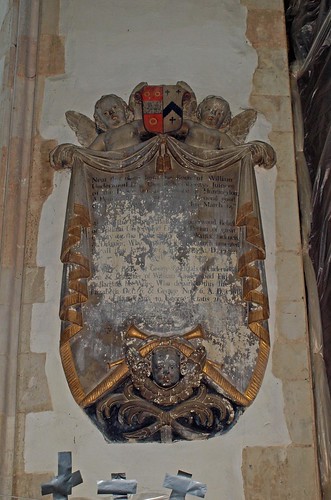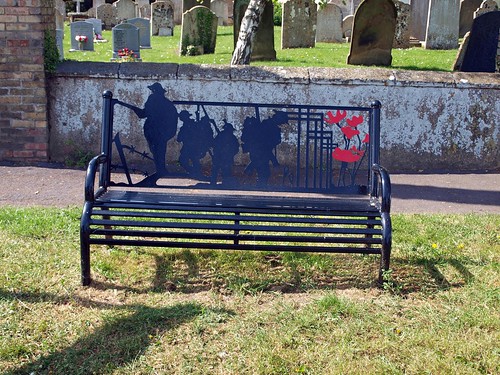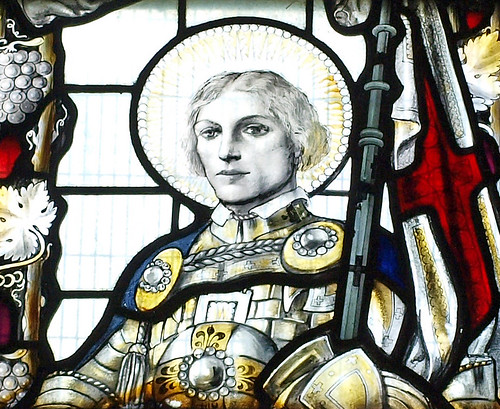This should be, for such a large church, full of interest both externally and internally but sadly it's not. Perhaps tellingly the most interesting item I found was the same WWI memorial bench that I found at Ramsey.
ST JOHN. An almost completely E.E. church, perhaps so sweepingly done because at Somersham was a palace of the Bishops of Ely. Externally the chancel has single widely spaced lancets along its sides and a group of over-restored lancets in the E wall. The S and the N aisle doorways have mature stiff-leaf (N badly preserved) and arches of many mouldings. The windows of the aisles are Perp, as is the clerestory. Only the W tower with its spike is later. One W window looks c.1300, and the bell-openings are Dec. Internally the four-bay arcades have piers of four shafts and four thin polygonal shafts in the diagonals and typically E.E. moulded capitals. The crenellation is of course a Perp re-cutting. The bases, except those of the responds, are also re-cut. Double-hollow-chamfered arches with a step between the chamfers. Moreover E.E. tower arch with keeling, chancel arch with keeling, and PISCINAS in the chancel, S aisle, and N aisle. In the chancel the SEDILIA have responds in the form of stiff-leaf corbels. The chancel side lancets are surrounded by a continuous thin roll, but the E lancets are fully shafted. The nave roof is Perp and has a large number of carved bosses. The structure consists of tiebeams on arched braces, the braces sweeping up in the same curvature to the ridge-piece, a very fine effect. - CHANDELIER. of brass. 1787. Two tiers of arms. The centre is of a very Baroque, baluster-like shape. - PLATE. Cup 1569-70; Flagon 1638-9; Paten 1812-13; Plate undated. - BRASS. Priest, early C16, 2 ft long (chancel floor).
SOMERSHAM. Here the Bishops of Ely had a palace for centuries, and the manor is known to have been part of the settlement on Henrietta Maria at her marriage to Charles Stuart. Its church has been keeping watch 700 years upon these meadows with their Roman memories; its weathervane has been showing the way of the wind since the 18th century.
It is good to see that in our own day the village has made good the noble roof of its nave, with beams and bosses of the 14th century, the work of splendid craftsmen. It is boldly carved; we noticed Richard the Second and his Queen, a bishop and a mermaid, a wolf and a lion, an eagle with two heads, and the serpent with the apple which has brought us all so low. The wall-posts rest on remarkably fine stone corbels, on which is an angel with a sword, a man crouching and a man on one knee, praying men in tunics, and a man with a hood thrown carelessly back. The 13th century chancel arch has heads of a man and a woman and there are old stone faces in one of the aisles. There is a Tudor brass with a rather crude portrait of an unknown priest, a Tudor chalice, a Jacobean chair carved with flowers, and a chest dug out of a rough tree trunk guarded with five locks. A sundial has been marking time 200 years.
It is good to see that in our own day the village has made good the noble roof of its nave, with beams and bosses of the 14th century, the work of splendid craftsmen. It is boldly carved; we noticed Richard the Second and his Queen, a bishop and a mermaid, a wolf and a lion, an eagle with two heads, and the serpent with the apple which has brought us all so low. The wall-posts rest on remarkably fine stone corbels, on which is an angel with a sword, a man crouching and a man on one knee, praying men in tunics, and a man with a hood thrown carelessly back. The 13th century chancel arch has heads of a man and a woman and there are old stone faces in one of the aisles. There is a Tudor brass with a rather crude portrait of an unknown priest, a Tudor chalice, a Jacobean chair carved with flowers, and a chest dug out of a rough tree trunk guarded with five locks. A sundial has been marking time 200 years.



No comments:
Post a Comment